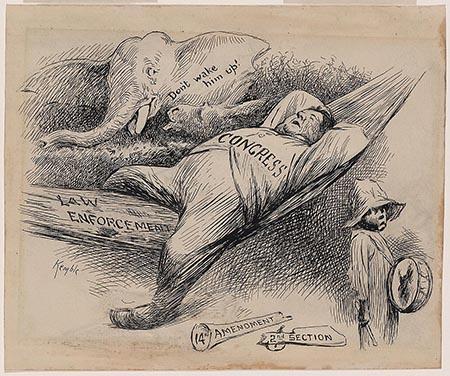14th Amendment, 2nd Section (1902)
Cartoon shows Congress as a fat man asleep in a hammock labeled "Law Enforcement." A broken blunderbuss, labeled "14th Amendment, 2nd Section," lies at his feet. A small black boy walks by holding a drum, but an elephant cautions, "Don't wake him up!" The second section of the 14th Amendment provided for reducing a state's apportionment in Congress if the state prevented any male from voting for any reason other than participation in a rebellion or other crime. There was agitation by various black groups in the early years of the 20th Century to enforce it, but no serious attempts by the Republican-led Congress were made. The artist, E. W. Kemble, was a prolific cartoonist and illustrator, best known for his portrayal of African Americans. (Image description from Library of Congress)

Kemble, E. W. (Edward Windsor). "Congress-14th Amendment 2nd section/Kemble." 1902. Drawing. From Library of Congress Prints and Photographs Division. http://www.loc.gov/pictures/item/2004679121/ (Accessed August 6, 2018).
Public Domain
Public Domain is a copyright term that is often used when talking about copyright for creative works. Under U.S. copyright law, individual items that are in the public domain are items that are no longer protected by copyright law. This means that you do not need to request permission to re-use, re-publish or even change a copy of the item. Items enter the public domain under U.S. copyright law for a number of reasons: the original copyright may have expired; the item was created by the U.S. Federal Government or other governmental entity that views the things it creates as in the public domain; the work was never protected by copyright for some other reason related to how it was produced (for example, it was a speech that wasn't written down or recorded); or the work doesn't have enough originality to make it eligible for copyright protection.